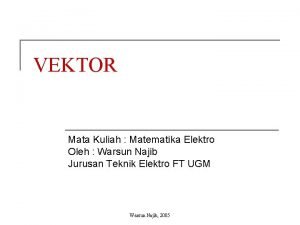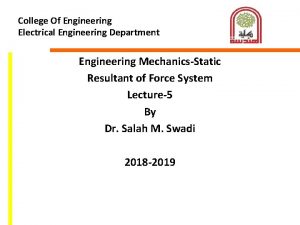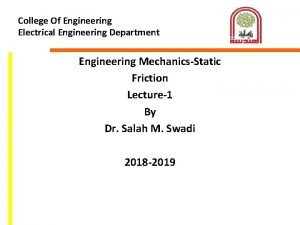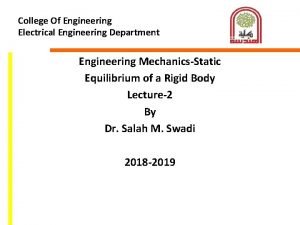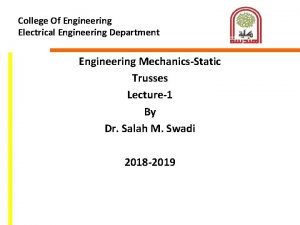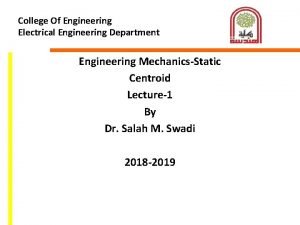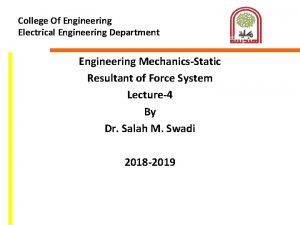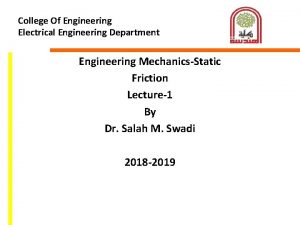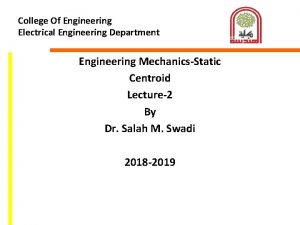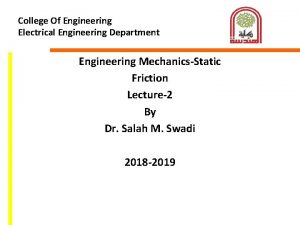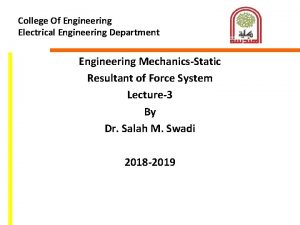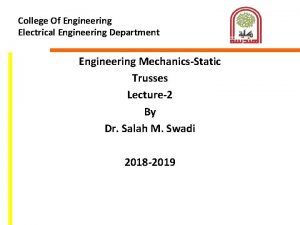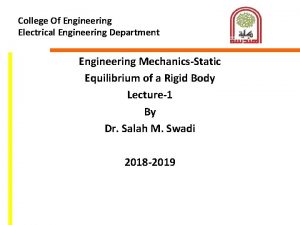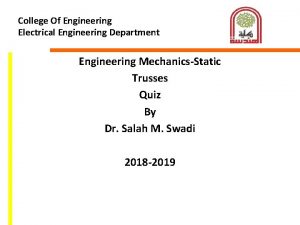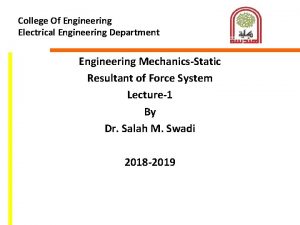College Of Engineering Electrical Engineering Department Engineering MechanicsStatic















- Slides: 15

College Of Engineering Electrical Engineering Department Engineering Mechanics-Static Centroid Lecture-3 By Dr. Salah M. Swadi 2018 -2019

9. 4 Resultant of a General Distributed Loading Pressure Distribution over a Surface • Consider the flat plate subjected to the loading function ρ = ρ(x, y) Pa • Determine the force d. F acting on the differential area d. A m 2 of the plate, located at the differential point (x, y) d. F = [ρ(x, y) N/m 2](d A m 2) = [ρ(x, y) d A]N • Entire loading represented as infinite parallel forces acting on separate differential area d. A

9. 4 Resultant of a General Distributed Loading Pressure Distribution over a Surface • This system will be simplified to a single resultant force FR acting through a unique point on the plate

9. 4 Resultant of a General Distributed Loading Magnitude of Resultant Force • To determine magnitude of FR, sum the differential forces d. F acting over the plate’s entire surface area d. A • Magnitude of resultant force = total volume under the distributed loading diagram • Location of Resultant Force is

9. 5 Fluid Pressure • According to Pascal’s law, a fluid at rest creates a pressure ρ at a point that is the same in all directions • Magnitude of ρ depends on the specific weight γ or mass density ρ of the fluid and the depth z of the point from the fluid surface ρ = γz = ρgz • Valid for incompressible fluids • Gas are compressible fluids and the above equation cannot be used

9. 5 Fluid Pressure Flat Plate of Constant Width • Consider flat rectangular plate of constant width submerged in a liquid having a specific weight γ • Plane of the plate makes an angle with the horizontal as shown

9. 5 Fluid Pressure Flat Plate of Constant Width • As pressure varies linearly with depth, the distribution of pressure over the plate’s surface is represented by a trapezoidal volume having an intensity of ρ1= γz 1 at depth z 1 and ρ2 = γz 2 at depth z 2 • Magnitude of the resultant force FR = volume of this loading diagram

9. 5 Fluid Pressure Curved Plate of Constant Width • When the submerged plate is curved, the pressure acting normal to the plate continuously changes direction • Integration can be used to determine FR and location of center of centroid C or pressure P

9. 5 Fluid Pressure Flat Plate of Variable Width • Consider the pressure distribution acting on the surface of a submerged plate having a variable width • Since uniform pressure ρ = γz (force/area) acts on d. A, the magnitude of the differential force d. F = d. V = ρ d. A = γz(xdy’)

9. 5 Fluid Pressure Flat Plate of Variable Width • Centroid V defines the point which FR acts • The center of pressure which lies on the surface of the plate just below C has the coordinates P defined by the equations • This point should not be mistaken for centroid of the plate’s area

Example 9. 14 Determine the magnitude and location of the resultant hydrostatic force acting on the submerged rectangular plate AB. The plate has a width of 1. 5 m; ρw = 1000 kg/m 3.

Solution The water pressures at depth A and B are For intensities of the load at A and B,

Solution For magnitude of the resultant force FR created by the distributed load. This force acts through the centroid of the area, measured upwards from B

Solution Same results can be obtained by considering two components of FR defined by the triangle and rectangle. Each force acts through its associated centroid and has a magnitude of Hence

Solution Location of FR is determined by summing moments about B
 Electrical engineering department
Electrical engineering department Tum
Tum Ucla electrical engineering
Ucla electrical engineering Pasadena city college police department
Pasadena city college police department Vector electrical engineering
Vector electrical engineering Gwu electrical engineering
Gwu electrical engineering Tel aviv university electrical engineering
Tel aviv university electrical engineering Northwestern electrical engineering
Northwestern electrical engineering Klipsch school of electrical and computer engineering
Klipsch school of electrical and computer engineering Umd electrical engineering
Umd electrical engineering Cleat wiring system
Cleat wiring system Electrical engineering environmental issues
Electrical engineering environmental issues Cs flowchart wpi
Cs flowchart wpi Electrical engineering presentation
Electrical engineering presentation Electrical engineering kfupm
Electrical engineering kfupm Big data in electrical engineering
Big data in electrical engineering




